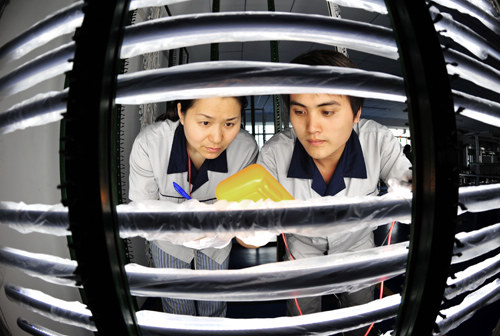|
 |
|
BENEFITTING LEDS: Employees of Tianjin Promlite Technology Co. Ltd., a manufacturer of LED lamps, run tests on products. The phase-out plan of incandescent lamps is expected to deliver a boost to the LED industry (LIU HAIFENG) |
After 130 years of using incandescent lamps, China is determined to abandon the energy-guzzling bulbs in favor of more energy-efficient ones.
On November 1, the Development and Reform Commission (NDRC) and five other government departments jointly released a joint circular, vowing to gradually halt imports and sales of the traditional incandescent lamps.
Those lamps are widely used for both household and commercial lighting. Electricity is used to heat up the thin wire filament inside the bulb until it glows and produces light. Unfortunately, while incandescent bulbs are effective at illuminating even the darkest of spaces, they are not energy efficient. Much of the electricity is used to make heat, and light is only a by-product.
In 1882, China's first incandescent lamp was used in Shanghai, providing a more reliable alternative to oil lamps and candles. In the past 130 years, China has become the world's largest producer and consumer of incandescent bulbs. In 2010, the country's output of such bulbs stood at 3.85 billion, with sales hitting 1.07 billion yuan ($168.47 million).
As China embarks on a greener path of development, it is aiming to phase out these less efficient bulbs.
"This move is part of the government's vigorous efforts to push forward energy conservation and emission reduction," said Xie Ji, Deputy Director of Resource Conservation and Environment Protection under the NDRC.
The effort to replace incandescent lamps with energy-efficient ones nationwide will help save 48 billion kwh of electricity and reduce 48 million tons of carbon dioxide emission annually, said Xie.
"This year marks the beginning of the 12th Five-year Plan (2011-15), which is focused on economic rebalancing. Meanwhile, the United Nations Climate Change Conference is about to convene in Durban, South Africa," said Xie. "Against this background, China is taking swift action to propel green lighting and implementing effective measures in response to climate change."
Xie said some manufacturers of incandescent lamps in the country have been transforming their businesses and reducing production. NDRC data showed that in 2010 there were 10 enterprises nationwide with annual output of more than 100 million incandescent lamps, accounting for at least 70 percent of the industry's total output of such lamps.
China has been firmly committed to improving energy efficiency. In 1996, the Chinese Government launched a green lighting program, promoting wider use of energy-efficient lamps with heavy subsidies. Moreover, the country has joined hands with the United Nations Development Program and Global Environmental Facility to initiate a project aimed at lifting the quality and competitiveness of China's energy-efficient lighting products.
The circular said those projects have significantly helped China's lighting industry move up the value chain and improve product quality. In 1996, China's output of energy-efficient lamps was barely 3 percent of that of incandescent bulbs, but the ratio jumped to 1:1 in 2010. Last year, the country's output of energy-efficient lamps amounted to 4.26 billion, accounting for 80 percent of the world's total. There were around 20 manufacturers with annual output surpassing 50 million, making up 82.2 percent of the industry's overall output.
"Meanwhile, techniques of Chinese manufacturers have advanced to the world-leading level," added Xie. "In addition, semi-conductor lighting technologies are also maturing quickly."
Hua Shuming, Director of the National Lighting Test Center, said the service life of a qualified energy-efficient lamp is more than 6,000 hours, six times that of an incandescent bulb. A 13-watt energy-efficient lamp can produce illumination comparable to that of a 60-watt incandescent lamp, and it is able to reduce electricity consumption by 60-80 percent.
Energy-efficient lighting products are being recognized by global consumers. Data from the NDRC showed that Chinese energy-efficient lamps controlled 85 percent of global markets, up from only 20 percent in 1996.
| 